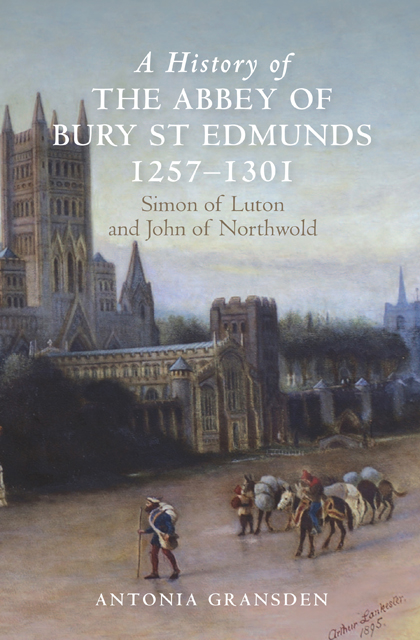Book contents
- Frontmatter
- Dedication
- Contents
- List of plates
- List of figures
- Preface
- Editorial note
- Dedication
- Acknowledgements
- Abbreviations
- Maps and plans (figures 1–11)
- Part I Introduction
- Part II Abbatial Governance
- Part III The Abbey’s Economy
- Part IV Religious Life and Reform
- Part V Intellectual and Cultural Life
- Appendix I The identity of the abbot’s justices, Henry of Guildford and Henry of Shenholt (in 1287)
- Appendix II The monks’ dietary regime: their food and drink
- Select List of the Registers and Customaries Cited
- Select List of Further Manuscripts Cited
- Select Bibliography
- Index
- Backmatter
Appendix I - The identity of the abbot’s justices, Henry of Guildford and Henry of Shenholt (in 1287)
Published online by Cambridge University Press: 22 February 2023
- Frontmatter
- Dedication
- Contents
- List of plates
- List of figures
- Preface
- Editorial note
- Dedication
- Acknowledgements
- Abbreviations
- Maps and plans (figures 1–11)
- Part I Introduction
- Part II Abbatial Governance
- Part III The Abbey’s Economy
- Part IV Religious Life and Reform
- Part V Intellectual and Cultural Life
- Appendix I The identity of the abbot’s justices, Henry of Guildford and Henry of Shenholt (in 1287)
- Appendix II The monks’ dietary regime: their food and drink
- Select List of the Registers and Customaries Cited
- Select List of Further Manuscripts Cited
- Select Bibliography
- Index
- Backmatter
Summary
Henry of Guildford
A pension of four marks p.a. is recorded in the sacrist’s register, CUL MS Additional 6006, f. xviij. This information enabled Paul Brand to identify him. I now quote from Paul Brand’s letter to me, with his kind permission:
There are two contemporaries called Henry of Guildford: Henry Gerard of Guildford (who was a clerk of John de Lovetot) and Henry Marshall of Guildford (who was a clerk of Solomon of Rochester and later a Common Bench justice), and they are not always adequately distinguished in contemporary sources. Fortunately it is possible to be certain that the man who appears in your list is Henry Gerard of Guildford, for in Hilary term 1294 he sued the abbot of Bury for twenty marks arrears of this very annuity of four marks a year which had been granted to him by the abbot at 12 kal. February 12 Edw. I (21 January 1284) at Culford: TNA, CP 40/103, m. 127d. His connexion with John de Lovetot went back to at least 1276 and he was chosen as an auditor by John’s executors in 1296; he had previously been a clerk of master Richard of Staines. He was convicted of misconduct while in Lovetot’s service and imprisoned in the Tower in 1290 but was ransomed for 100 marks.
Henry of Shenholt (‘de Schineholt’)
Paul Brand identifies him in a letter to me which I quote, again with his kind permission:
Henry de Schineholt was a clerk in the service of Solomon of Rochester, the senior justice of the ‘southern’ eyre circuit of the eyre, from 1281 onwards (and there is a reference in a complaint about him at 1287 Hertfordshire eyre which shows him writing a plea roll there at the dictation of his senior colleague, Robert of Preston), but after Rochester’s disgrace in 1290 he passed into the service of his successor as senior justice of that circuit, John of Berwick, in whose service he is still to be found at the time of the 1299 Cambridgeshire eyre. I think the name may be derived from a place name in Buckinghamshire (he is stated to have been from Shenholt in Bucks in a Kent assize of 1203: TNA, JUST 1/1323, m. 43) but I have not found it in the English Place Name Society volume.
- Type
- Chapter
- Information
- A History of the Abbey of Bury St Edmunds, 1257-1301Simon of Luton and John of Northwold, pp. 293 - 294Publisher: Boydell & BrewerPrint publication year: 2015

